The information onthese pages has come from too many sources to list, most of them online. I do not promise this information is correct, I am not an Egyptologist, I am just using my best judgement to try and provide the best information I can about the history and origins of the deity known as Horus.
Who is Horus?
Falcons appear in Egyptian history as far back as we have evidence, but whether they are Horus or not is another matter. The vast majority of what we know about Egyptian religion comes from the New Kingdom and later when Egypt was ruled over by Greece (the Ptolomies and Cleopatra). Also kings and Gods had many names in ancient Egypt, partly because knowledge of something's true name was believed to give you power over that thing, so the real name was rarely used.
The Egyptian word "hr", from which the god's name is derived, means "the one on high", or "the distant one", probably in reference to the soaring flight of the hunting falcon. Mythologically, the god was imagined as a falcon, whose right eye was the sun and left eye was the moon. Birds also represented the soul of a person which flew away at death.
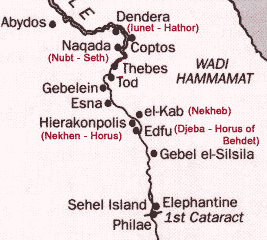
Horus (Hr) was the patron of the Nekhen (Hierakonpolis) monarchy that grew into the historical pharaonic state and hence, the first known national god. Hr is ruler of the heavens and protects the kings of Upper Egypt. Hr was the first Pre-Dynastic god to rule "the two lands" and achieve nation-wide recognition. The official emblem of the ruling kings of the First and Second Dynasty, the serekh, always shows Hr, and kings were called Hr - for example, Hr Narmer, Hr Djer, Hr Aha. Across the river on the east bank from Nekhen was Nekheb ruled over by vulture goddess Nekhebet ("Lady of Nekheb"). Hr was worshipped through the entirety of Egyptian history from Pre-Dynastic times to the New Kingdom and by both the ruling classes and the common people.
The main locations of Upper Egyptian ancient Horus worship are Hierakonopolis and Edfu as seen on the map to the right. This area was inhabited and prosperous during the Pre-Dynastic period. However Horus proper (Horus the Elder) most likely originated in the delta cities of Damanhur and Letopolis as the winged solar disc. The Hierakonopolis version of Horus was originally called Nekhen. However evidence from Nile cities is few and far between due to flooding prior to the building of the Aswan dam. So we have two main falcon gods, one from upper egypt and one from lower egypt, merged into one in the pre-dynastic and/or early old kingdom period. The Horus of kingship from the south and the solar Horus from the north.
Read more about the cities associated with Horus.


Seth
During the 2nd dynasty (2925-2790 BCE) Seth replaced Horus and instead of a Horus name kings had a Seth name. To the right is an example from King Peribsen, he was buried at Umm el-Ka'ab (Abydos). The King who followed him, Kha'sekhemui (The Two Powers Arise), had both on his serekh (see left) indicating that he resolved whatever issue had started the Seth-name stuff. He was the final king of the 2nd dynasty.
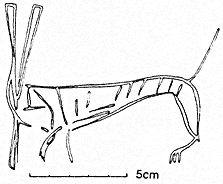 Seth had a temple in Naqada (Nubt/Ombos) in Upper Egypt dated
around 1500 BCE (New Kingdom, 18th Dynasty) and he is referred to in the
Pyramid texts as Set of Nubet. The earliest depiction of Seth comes from
the Naqada III period (Dynasty 00) in the Gebel
Tjauty graffiti, found in the Desert west of Thebes (not very far from
Naqada). The grafitti appears to relate a victory over the town of Naqada
by King Scorpion of Abydos. Seth animals are also seen among the standards
of his followers on his macehead found at Nekhen (also falcons, a jackal,
and the god Min).
Seth had a temple in Naqada (Nubt/Ombos) in Upper Egypt dated
around 1500 BCE (New Kingdom, 18th Dynasty) and he is referred to in the
Pyramid texts as Set of Nubet. The earliest depiction of Seth comes from
the Naqada III period (Dynasty 00) in the Gebel
Tjauty graffiti, found in the Desert west of Thebes (not very far from
Naqada). The grafitti appears to relate a victory over the town of Naqada
by King Scorpion of Abydos. Seth animals are also seen among the standards
of his followers on his macehead found at Nekhen (also falcons, a jackal,
and the god Min).
There is a mythic history of conflict between Horus and Seth but the origins of the myth are hard to find. Seth became villified during the 2nd intermediate period (15th dynasty, c1600 BCE) when the Hyksos invaded Egypt from western Asia and adopted Seth.
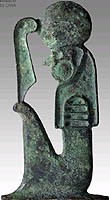
Ra of Heliopolis
Heliopolis (Iunu) in Lower Egypt had a solar hawk god called Ra who was known also as "RA HOR AKHT Y" ("RA, the HOR, or king, of the Two Horizons"). Ra and Horus appear very similar, they are both hawk headed, they are both heavenly rather than earthly deities. But Ra is predominantly solar, seen by the solar disk on his head, whereas Horus originates as a representation of kingship and is a sky rather than sun god. Ra is also very ancient, the ensign to the right is from 2925–2700 BCE in the 2nd Dynasty. From the 4th Dynasty kings become known as sons of Ra. Ra and Horus become Re-Horakhty (Re is Horus of the Horizon).
However the main cult city of Ra (Heliopolis) is very close to the main cult city of the original Horus the Elder (Letopolis/Khem). Were they the same God? Perhaps the original northern Ra/Horus/Khenty-irty split in two when he was fused with the northern Horus/Nekhen leaving behind Ra of Heliopolis with the solar attributes of the original deity.
Archaeological Evidence
Pre-Dynastic
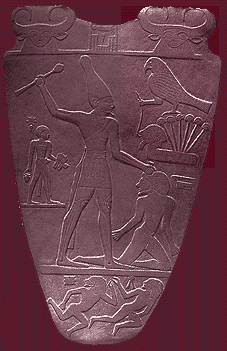
The Palette of Narmer (3100-3000 BCE)
The Palette of Narmer was found in 1898 in the "main deposit" of the temple of Horus in Hierakonpolis. Most likely a commerative work of art celebrating the victory of Narmer (Menes) of Upper Egypt over Lower Egypt. It is believed that Narmer is King Menes, the 'mythical' unifier of Upper and Lower Egypt.
On the rear of the palette Narmer wears the White Crown of Upper Egypt (he wears the Red Crown of Lower Egypt on the front). He holds a captive representing the defeated army. In the top right corner we see a glyph of the larger image; the Horus bird represents King Narmer perched over the papyrus plants representing Lower Egypt holding the head of his enemy. At the top of the palette we see two cows heads representing the Goddess Hathor.
Horus was the divine King, the King was Horus and one of his names (he had five) was known as his Horus name. Hathor was the protector of the King, her name means House of Horus.
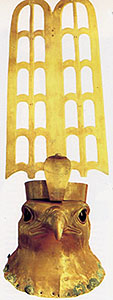
Gold Head of Nekheny
A large ceremonial center was excavated out on the low desert near Hierakonpolis, which dates back to early Naqada II (Dynasty 0). Situated in the southern portion of the city enclosure of Nekhen stood the great temple to the city's falcon god, Nekheny or The Nekhenite. The temple itself covered approximately one-sixth of the total area and it would have dominated not only the temple complex, but the town itself. Some of the greatest finds to come from the Temple Complex were a cache of ceremonial items which included the palette of Narmer and a great golden head of a falcon (c2300 BCE, 6th Dynasty, Old Kingdom, the oldest (known) cult image in existence).
More info on the cities of Horus page.
Iry-Hor
Iry-Hor is the oldest ruler of Egypt (although he probably only ruled a region of Egypt) that is known by name, and who has some attributions to prove his existence. His name probably means "belonging to Horus", however the symbols were found only on some jars and not in a serekh, so it may not be his name but a sign that the items belonged to the royal treasury or similar. However either interpretation implies the association of Horus with kingship. Iry-Hor was buried in Abydos and ruled around 3100 BCE in the Pre-Dynastic period called Naqada II or Dynasty 0. Abydos was the cult center for Osiris, the God of the Dead. Early religious belief required that pharaohs be buried in Abydos in order to achieve the afterlife -- which accounts for the many pre-dynastic and old kingdom pharaohs buried in the necropolis here.

The Double Falcon
The god Antaios (Antwey/Nemty/Anty) is usually stated to be originally a double god, "the two falcons", that was later joined to create one, probably that of Horus. However I can find no proof of this gods existance. There are late pre-dynastic royal serekhs (Naqada III, Dynasty 0) found on jars from El-Beda and Tura showing a double falcon, this king is thus known as 'Double Falcon' although whether he is one individual is unknown.
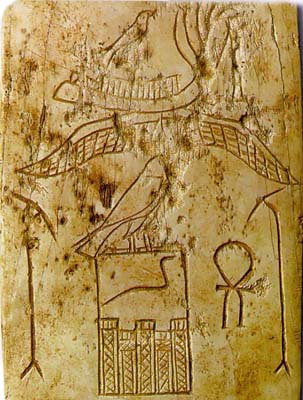
Winged Sun Disk
The ivory comb on the right comes from the period of King Djet (3000 BCE) of the 1st Dynasty, buried in Tomb Z in Abydos. The square with the falcon on top and serpent is the traditional serekh containing his name, the Horus Cobra. The comb also shows the sun barc with wings very similar to the traditional winged solar disc which came to represent Horus of Behdet/Edfu. An inscribed block from the mortuary temple of the 5th Dynasty (end of the Old Kingdom) ruler Sahura (2487-2475 BCE) found in the Abusir (located at a couple of km north of Saqqara) includes a full winged disc above his names and titles, with the phrase 'Horus of Behdet' written beside it.
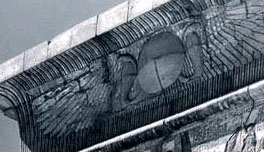
The south entrance to the New Kingdom temple of Montu built by Amenhotep III (18th dynasty) in Karnak has a large winged sun disk with uraeus over it. As does the Temple of Ramesses III (20th dynasty) at Medinet Habu in Thebes, though in colour without the uraeus. The New Kingdom temple of Horus at Edfu has a series of six winged disks in its entrance all with different attributes. I'll be damned if I can find any visual examples of earlier examples like the one mentioned above from Memphis.

Old Kingdom
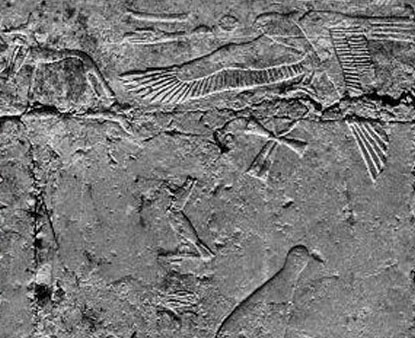
Djoser/Netjerykhet (c2620-2600 BCE)
Djoser is one of the most important kings of the Old Kingdom (actually the 3rd dynasty links the old kingdom to the pre-dynastic period) and of the whole long history of Egypt, he was responsible for the first pyramids. He ruled during the start of the 3rd Dynasty, his son was the architect Imhotep. His tomb is in Saqqara (Step Pyramid II).
The relief to the right is from his tomb in Saqqara. We can see the serekh containing his name by his crown. More interestingly above him, clutching an ankh in its claws, is a beautifully rendered hawk. This motif is seen on several other similar reliefs in the tomb. Next to the hawk is an Anubis (Anpu) style dog.

Khafre (6.5' tall diorite 2500 BCE)
Khafre was the Pharoah who built the second pyramid (Pyramid of Chephren) and the Sphinx on the Giza plateau in Egypt (2576-2551 BCE, 4th Dynasty). This statue was found in the valley temple in Giza. Horus did not rule directly, but incarnated in a human being and ruled through this human who then became a half-god or a Per-o (or pharaoh).Middle Kingdom
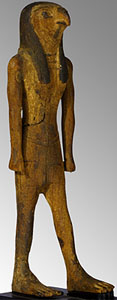
Heru sma taui (2133-1991 BCE)
This polychrome wooden statuette represents the god Horus, with the head of a falcon and the body of a man, in the striding stance typical of royal iconography. It is from Dynasty 11. As the personification of the god who made the sky he was called Heru (“he who is above”). The forms of Horus mentioned in Egyptian texts are numerous. Here we have Heru sma taui (“Horus, the uniter of the South and North”). 24.4cm inheight it comes from Herakleopolis (O.K. Tomb).
Udjat/Wedjat Eye
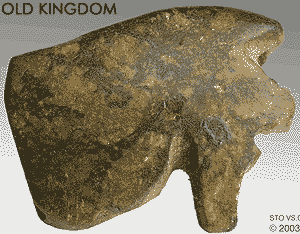
Instantly recognizable, the Udjat Eye (also wedjat, uzat) remained one of the most popular amuletic symbols from the Old Kingdom to Roman times. Although Egyptians designed countless variations on the theme over this 2500 year period, the basic design remained constant: the eye of the God Horus, drawn as a human eye with a cosmetic line extending from the outer corner of the eye, an enhanced eyebrow line, and a stylized marking below the eye evoking the cheek of a falcon.
The amulets to the right are 1.4cm from the Old Kingdom (2686–2181 BCE) from a royal tomb in Saqqara and 5.6cm from the 18th Dynasty of the New Kingdom (1410–1293 BCE) from Thebes.
The Egyptian word udjat means “sound”, “whole”, or “undamaged” and the eye was reputed for its great healing and protective power. But it has many meanings, including “The strength of the monarch, the concept of kingship, protection against Seth [chaos], royal purification agent, wine, and offerings at the festival of the waxing moon.”
In a myth Seth gouged out Horus’ left eye during the fight over who should be king. Hathor or Thoth (depending on which version) intervened and healed the eye with gazelle milk (Hathor) or royal saliva (Thoth). The eye thus became a symbol of miraculous healing. The plucked and then restored left eye symbolized the moon, with the phases of the moon reflecting the damaged, plucked, healing, and healed conditions of the eye over time. Despite this udjat eyes can be left or right or even a pair.
New Kingdom
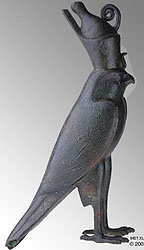
Temple of Horus (Edfu/Tbot/Djeba)
This large bronze statuette (22cm) from the New Kingdom (probably Dynasty 18, 1570–1200 BCE) represents the falcon god, ‘lord of the sky’, elemental Horus, and primordial symbol of kingship. As ‘Lord of the Two Lands,’ he wears the double-crown of Upper and Lower Egypt. The level of craftsmanship exhibited not only in the general modeling, but also in the delicate engraving of the plumage is simply extraordinary.
The Four Sons of Horus
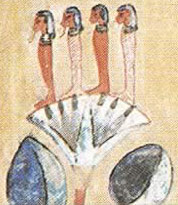
Their names are Imsety (imsti), Hapy (hpy, not to be confused with the Nile river god, Hapi), Duamutef and Kebehsenuef. All references we have to these deities are funerary in context, and it appears that no cults ever honored them. The earliest extensive religious text, known as the Pyramid Texts (5-6th dynasty, 2350-2175 BCE), mentions them a total of fourteen times. Spell 2078 and 2079 describe them as, "friends of the king, (who) attend on this King... the children of Horus of Khem (letopolis); they tie the rope-ladder for this King. they make firm the wooden ladder for this King, they cause the King to ascend to Khepri when he comes into being in the eastern side of the sky". From Spell 1333, we learn that they, "spread protection of life over your father the Osiris King, since he was restored by the gods", while Spell 552 tells us that, "I will not be thirsty by reason of Shu, I will not be hungry by reason of Tefnut; Hapy, Duamutef, Kebehsenuef, and Imsety will expel this hunger which is in my belly and this thirst which is on my lips".
From the Middle Kingdom through the Greco-Roman era, these deities are referenced in almost every tomb, and their powers are invoked upon almost all coffins and canopic equipment. On canopic equipment, their heads were originally depicted as human. Between the early 18th and the middle 19th Dynasty, their heads began to be depicted differently, with Imsety's head remaining human, while Hapy became an Ape, Duamutef a Jackal, and Kebeshsenuef a falcon. They continued to appear until as late as the 4th century CE.